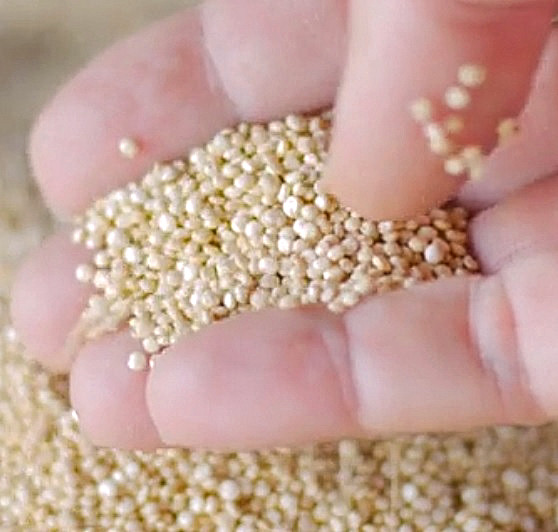Quinoa (Chenopodium Quinoa, Willd) is an annual plant that belongs to the Chenopodiaceae family. The Chenopodium genus includes about 150 species, including Chenopodium Quinoa, an important crop of high nutritional value. It grows at many different altitudes, from sea level to the height of Bolivian Altiplano at around 4,000 m above sea level and under various climate conditions. Quinoa has a broad genetic diversity, which allows it to adapt to various tough environments, including highlands, salinity, drought, and frost(1). Widely cultivated in Bolivia, Peru and Chile.

Chemical composition
The total amount of phenolic acids varies from 16.8 to 59.7 mg/100 g and the proportion of soluble phenolic acids varies from 7% to 61%. The phenolic acid content in Andean crops is low compared with common cereals like wheat and rye, but is similar to levels found in oat, barley, corn and rice. The flavonoid content of quinoa and kañiwa is exceptionally high, varying from 36.2 to 144.3 mg/100 g (2).
Potential health benefits
Quinoa protein has a balanced amino acid composition being rich in essential amino acids such as lysine (5.1–6.4%) and methionine (0.4–3.1%). The total dietary fiber content of quinoa grains (average of 4.1%) compares favorably with those of wheat (2.7%) and corn (1.7%). Moreover, the amounts of calcium, magnesium, iron, and phosphorus (especially calcium and iron) are significantly higher than in most other cereals. Quinoa oil is rich in polyunsaturated fatty acids such as linoleic and linolenic acid, which have the potential to help in degenerative diseases such as cardiovascular diseases, cancer, inflammatory and autoimmune diseases. Quinoa grains have high concentrations of polyphenols and antioxidants such as α‐ and γ‐tocopherol—compounds suggested to have anticarcinogenic and anti‐inflammatory activities. They are also a good source of vitamin C, E, and folic acid (3).
Increasing the utilisation of plant proteins is needed to support the production of protein-rich foods that could replace animal proteins in the human diet so as to reduce the strain that intensive animal husbandry poses to the environment. Lupins, quinoa and hempseed are significant sources of energy, high quality proteins, fibre, vitamins and minerals. In addition, they contain compounds such as polyphenols and bioactive peptides that can increase the nutritional value of these plants. From the nutritional standpoint, the right combination of plant proteins can supply sufficient amounts of essential amino acids for human requirements. This review aims at providing an overview of the current knowledge of the nutritional properties, beneficial and non-nutritive compounds, storage proteins, and potential health benefits of lupins, quinoa and hempseed (4).
Quinoa (Chenopodium quinoa Willd.) and amaranth (Amaranthus cruentus L.) are pseudocereal grains rich in both macronutrients and micronutrients including vitamins and minerals. The proteins are particularly of high nutritional quality due to the outstanding balance of essential amino acids. However, recent research strongly suggests that nonessential nutrients such as phytochemicals of quinoa and amaranth may also have potential health beneficial effects. This review focuses on the phytochemical composition of quinoa and amaranth seeds, the antioxidant and anti-inflammatory activities of hydrophilic (e.g. phenolics, betacyanins) and lipophilic (e.g. fatty acids, tocopherols, and carotenoids) nutrients, and how these contribute to the potential health benefits, especially in lowering the risk of the oxidative stress related diseases e.g. cancer, cardiovascular disease, diabetes, and obesity (5).
The good amount of essential fatty acids present in Quinoa have been shown to mitigate degradation, dehydration and inflammation of epidermal tissues by virtue of their antioxidant properties (6). Quinoa oil and extract are often included in sunscreen products as the polyphenols contained in Quinoa are able to absorb UV radiation (7).
Quinoa studies
References________________________________________________________________________
(1) Jacobson S. The worldwide potential for quinoa (Chenopodium quinoa Willd.) Food Rev Int. 2003;19:167–177. doi: 10.1081/FRI-120018883.
(2) Repo-Carrasco-Valencia R, Hellström JK, Pihlava JM, Mattila PH. Flavonoids and other phenolic compounds in Andean indigenous grains: quinoa (Chenopodium quinoa), kaniwa (Chenopodium pallidicaule) and kiwicha (Amaranthus caudatus) Food Chem. 2010;120:128–133. doi: 10.1016/j.foodchem.2009.09.087.
(3) Development of a fermented quinoa-based beverage.
Ludena Urquizo FE, García Torres SM, Tolonen T, Jaakkola M, Pena-Niebuhr MG, von Wright A, Repo-Carrasco-Valencia R, Korhonen H, Plumed-Ferrer C.
Food Sci Nutr. 2016 Oct 28;5(3):602-608. doi: 10.1002/fsn3.436.
(4) Bioactivities of alternative protein sources and their potential health benefits.
Pihlanto A, Mattila P, Mäkinen S, Pajari AM.
Food Funct. 2017 Oct 18;8(10):3443-3458. doi: 10.1039/c7fo00302a. Review.
(5) Phytochemicals in quinoa and amaranth grains and their antioxidant, anti-inflammatory, and potential health beneficial effects: a review.
Tang Y, Tsao R.
Mol Nutr Food Res. 2017 Jul;61(7). doi: 10.1002/mnfr.201600767.
(6) McCusker MM, Grant-Kels JM. Healing fats of the skin: the structural and immunologic roles of the omega-6 and omega-3 fatty acids. Clin Dermatol. 2010 Jul-Aug;28(4):440-51. doi: 10.1016/j.clindermatol.2010.03.020.
(7) Nichols JA, Katiyar SK. Skin photoprotection by natural polyphenols: anti-inflammatory, antioxidant and DNA repair mechanisms. Arch Dermatol Res. 2010 Mar;302(2):71-83. doi: 10.1007/s00403-009-1001-3.
![]() Quinoa
Quinoa 


